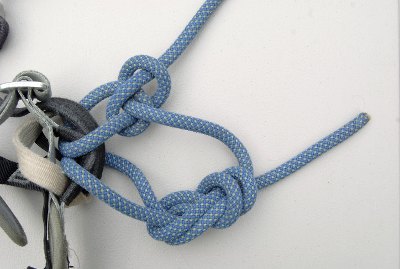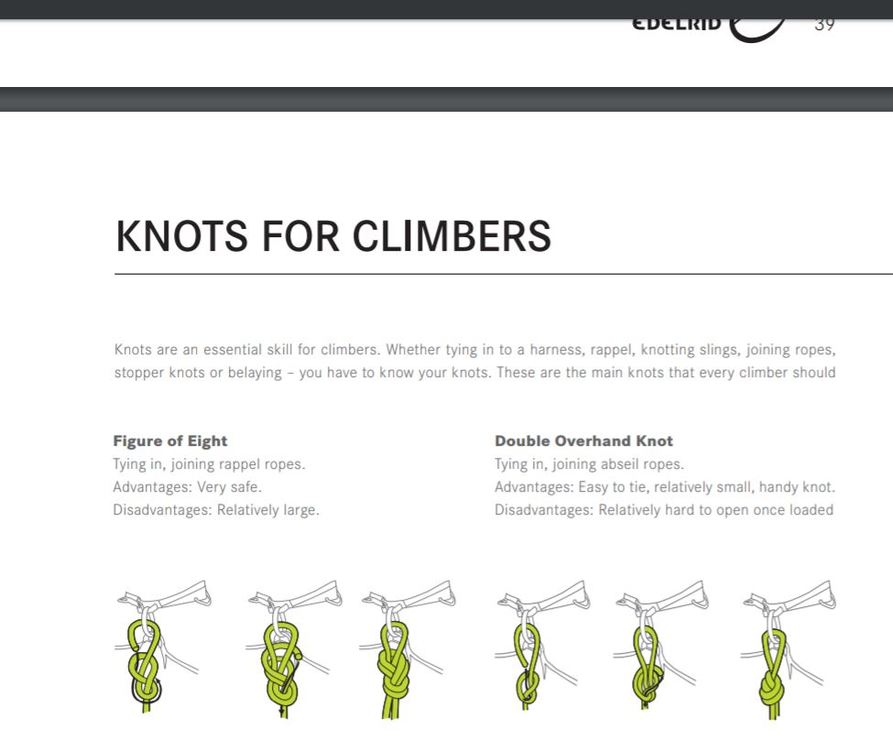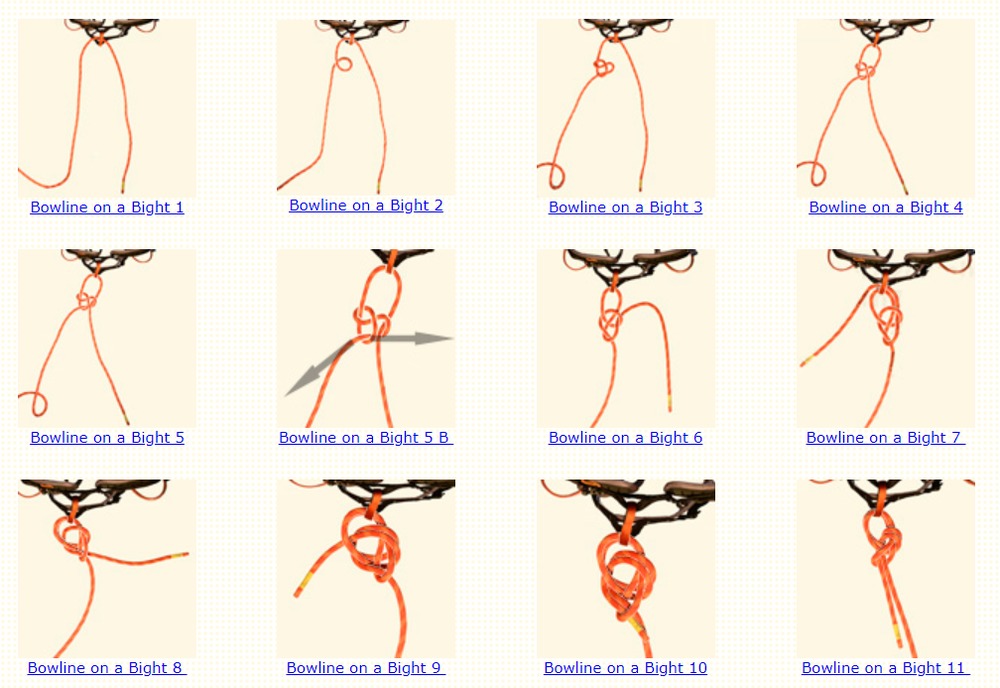Tie in knots
|
|
Oh, wait - I think I get it. Mark, you don't pre-tie a fig 8 on the standing end. You tie a bowline with no fig. 8 first, leaving a very long tail. Then you tie a fig. 8 on the tail, thread the end through the harness again, and finish the fig. 8 follow through. |
|
|
Spend some time working with 5-10 yr old scouts at one of their climbing facilities and see how much sense a 8 makes to someone who hasn't studied it already. It is absolutely that Americans don't learn the bowline first and nothing at all to do with one or the other being safer. Saying that an 8 is more reliable is just Americans showing a fetish for "my way or the highway". |
|
|
climbing friend, |
|
|
Live Perched wrote: Most videos showing how to tie a bowline on a bight show it being tied on a bight, which isn't really useful for tying into a harness. Here is a step by step guide for retracing it for a harness: http://www.climbing-knots.com/bowline-on-a-bight-knot.htmlIf you were distracted after step 6, you would still have a single bowline. I would not want to climb on it, but it would hold you in a fall. It is the same knot that Edelrid shows (page 40): https://www.edelrid.de/en/knowledge/RopeBook/Seilfibel_2015_EN.pdf?m=1507658268 I don't think that this knot is technically a double bowline, as Edelrid labels it. A double Bowline looks like this: https://en.wikipedia.org/wiki/Double_bowline |
|
|
The retraced bowline on a bight is not a double bowline, as Matt says. |
|
|
Aleks Zebastian wrote: climbing friend, Great description of Adam Ondra! |
|
|
rgold wrote: climbing friend, I see you have slapped my wang. through tubes of internet. it stings, it stings.But still he is the exception, most peoplez tying the bowline are elderly and very much like to pretend they free separate reality, valley of yosemite, with jangling hexes alone! |
|
|
You do have a point Aleks. The old folks all learned the bowline, and with a few stunning exceptions, aren't climbing at the level they used to be. Meanwhile, younger climbers don't learn it at all or are terrified of its overhyped death-dealing potential, so the bowlne demographic, a few people like Ondra notwithstanding, skews overwhelming older, with all that goes with advancing years. |
|
|
i think aleks and rgold having a civilized back and forth is peak mountainproject. lets end it here. |
|
|
rgold wrote: You do have a point Aleks. The old folks all learned the bowline, and with a few stunning exceptions, aren't climbing at the level they used to be. Meanwhile, younger climbers don't learn it at all or are terrified of its overhyped death-dealing potential, so the bowlne demographic, a few people like Ondra notwithstanding, skews overwhelming older, with all that goes with advancing years. Yes, I am old (-ish, >50), but I always tied an 8 until some young buck European friend taught me how to tie the bowline. Apparently, folks from across the pond use this knot with some regularity. |
|
|
MH, Thank you for posting the links. Equalizing the two rings/eyes on harness hard points is unlikely but is does present a very clean way to add diameter under the collar and a second loop. Many of you have probably read the Thomas Evans meta study on knot strength. Because of studies like the one below, I tend to favor 'eight' knots such as a Flemish bend or figure eight on a bight and even on a cord at a master point because they are symmetrical and everything I've read suggests 'eight' knots are stronger than alternatives. Knot strength (or really how little the knot diminishes the strength of the line or cord) matters to me because I use the same rope repeatedly and knot it in more or less the same place so I want to limit the amount my rope is stressed by falls, takes and hangs. I have not read about stress testing of these exotic bowlines yet I suspect the Yosemite, EBSB and double bowline on a bight all increase diameter under the collar (what I called the spine when I sailed), in loop (the rabbit hole) or both and probably reduce damage to the fibers. Below is a grab from the Evans' meta study. Read the paper; Evans does not conclude any knot covered (many more than just the bowline and figure eight) is not strong enough for rigging applications. Link: itrsonline.org/wordpress/wp… I must say, rgold and many others (but not all) on this thread taught me a lot and led me to valuable information. Cheers MP community!! |
|
|
normajean wrote: Lately been switching to double bowline with fisherman’s backup due to hand arthritis. Too much struggle to untie the figure 8. I think you mean double overhand backup. |
|
|
I prefer the "better" figure 8 follow with yosemite finish. There are 4 ways to tie a well dressed figure 8 follow knot. 2 are better than the others (and are mirror images). |
|
|
Aleks Zebastian wrote: climbing friend, sort of strange they show tying in through the belay loop... |
|
|
Figure eight. Because I fall a lot, and it's hard to untie when I've fallen a lot and my forearms are pumped and I like the extra workout sesh I get trying to untie it... |
|
|
Pete Spri wrote: From the DAV sicherheitsforschung / German Alpine association Safety commission: |
|
|
First, the yosemite finish is a myth, it does nothing to help you, as far as efficiency or ease of untying. If you fall regularly, and especially if you climb in humid places, then a single bowline, with a fishermans back up is super easy to check,, untie, and will never fail. I use two loops on my back up if the rope is regular to soft. On really stiff cords, I use three. |
|
|
David, I use the Yosemite finish to get the back-up knot off the tie in loop. Since almost all my climbing is with half ropes, I have two tie-in loops through the harness tie-in points, and adding backup knots to both those loops concentrates a lot of bulk at the harness tie-in. The tucked Yosemite finish I currently use is cleaner and more compact, and unlike the ordinary Yosemite finish and the figure 8, doesn't leave a dangling end you might mistakenly clip in a stressful situation. |
|
|
I don't know why I decided to read this "yet-another-knot-thread," but now that I have waded through it all I want to make a few points. |
|
|
SethG wrote: I don't know why I decided to read this "yet-another-knot-thread," but now that I have waded through it all I want to make a few points. There are standard safety procedures which have stood the test of time, there are also ones introduced to suit the low level of modern tuition and the need for rapid throughput needed to sell climbing as an "adventure sport" . Buddy checks fall into the second case. As climbing instructor since 1968 I am quite happy to ell people exactly why buddy checks are a waste of time and that an awareness of all that is going on around you at all times (including your partner tying in) is absolutely vital. You may think it is important, I have only climbed with one person ever who wished me to perform it.Your views on the bowline are incorrect. |

 Continue with onX Maps
Continue with onX Maps Continue with Facebook
Continue with Facebook

























